What could be better
If you are looking at this beauty, the two major drawbacks may reside in price and weight. It is an expensive lens and certainly not in everyone’s price range. However, it’s a great investment if you do professional architectural and landscape photography. In these areas, the minimal distortion works in your favor. There is no other lens that performs like this lens at the wider end.
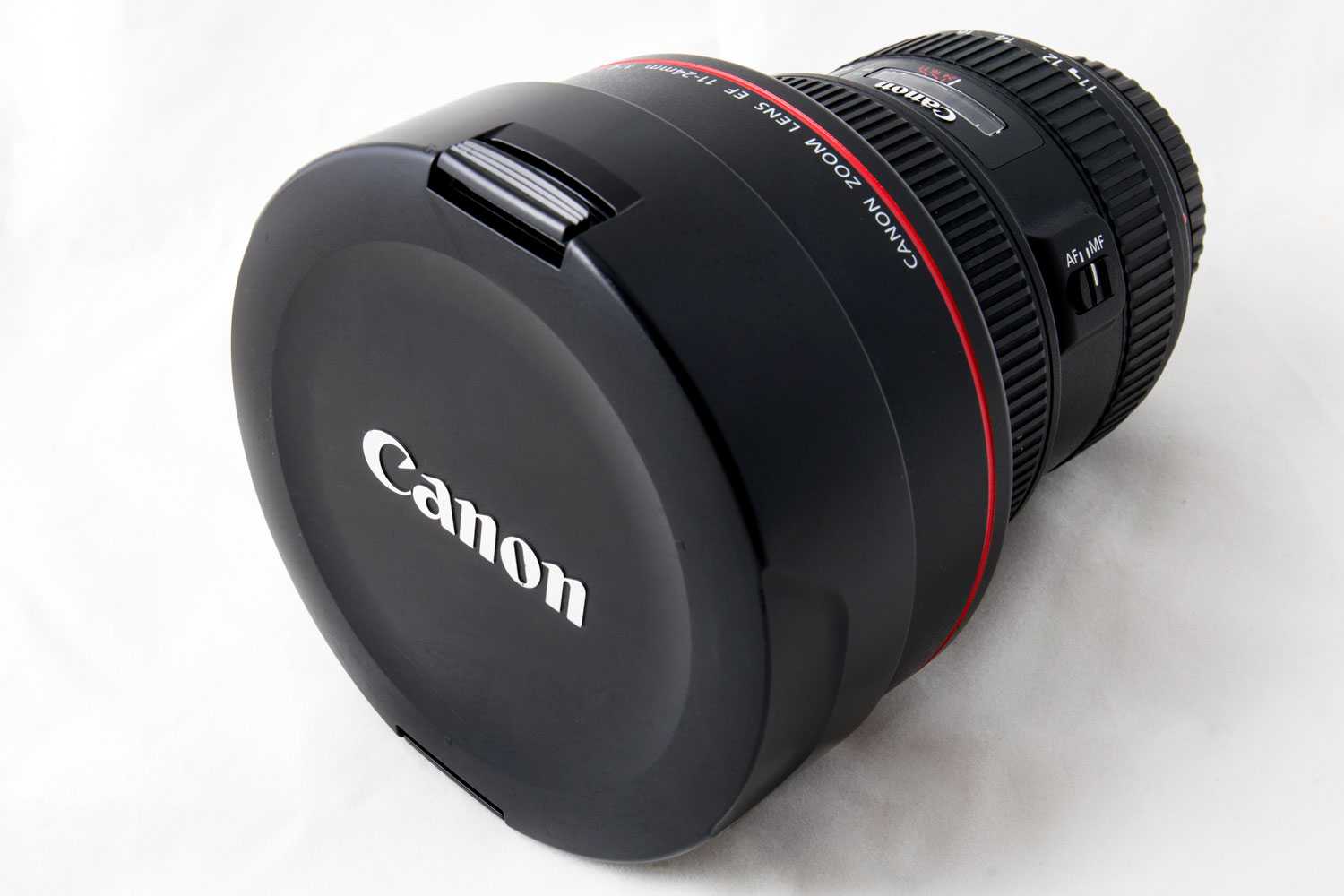
It is a large, heavy lens that will make you think twice before packing it for travel – you know you want it with you, oh but that weight! Even worse, it is front heavy, so you will want to be extra cautious when out in the field.
The front cap feels inadequate, as it struggles to cover the hood. There are also spaces where it clasps (when aligned) that leave room for dust to get into the front. After all the time they spent on this lens, the front cap feels like an afterthought.

There is also a noticeable amount of vignetting at 11mm and also some color fringing. Both are easy to fix in post-processing, without loss of your image quality. For an ultra-wide lens though, the falloff (or darkened corners) is negligible.
Canon EF 11-24mm f/4L USM – Features
Unlike a fisheye lens that produces a distinctly curvilinear wideangle result, where straight lines often appear curved, the EF 11-24mm f/4L USM is a rectilinear lens yielding images in which straight features, such as the walls of buildings, appear straight as to the human eye. Such is the time and effort put in by Canon’s engineers to ensure this lens displays minimal barrel or pincushion distortion, that at the time of its launch in 2015, it had the widest angle of view ever to be achieved by a rectilinear full-frame DSLR lens. That honour has now been passed to the Laowa 9mm f/5.6 FF RL lens, but to put Canon’s achievement into perspective, the angle of view of the 11-24mm lens (126° 5’) is so wide that there was the odd occasion when my tripod legs would creep into shot when composing in the portrait format.
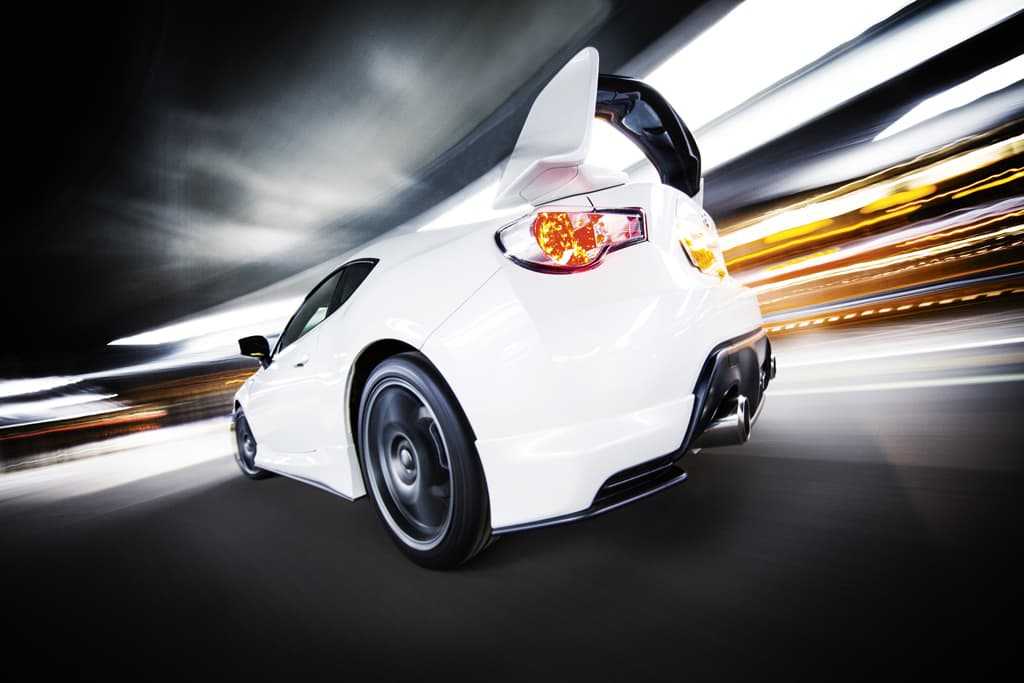
Shot at the widest end of the zoom, the lens was a little over a metre away from the subject during this car shoot
Turning our attention to the construction, the lens employs a 16-elements-in-11-groups arrangement, with four aspherical elements, one being the ground aspherical type to help tackle distortion. As to be expected from an L-series lens, ultra-low dispersion (UD) and super ultra-low dispersion elements also feature, as do three different types of lens coatings to guard against aberrations, ghosting and flare.
The USM abbreviation indicates that this lens uses Canon’s Ultra Sonic Motor technology to drive the autofocus system, and with full-time manual-focus override present, users can adjust the focus manually at any time without needing to flick the AF/MF switch to manual. With claims of a near-silent AF performance, the lens focuses with a low-frequency whirr that’s not picked up by the camera’s microphone, unless you record video in silence with no ambient sound.
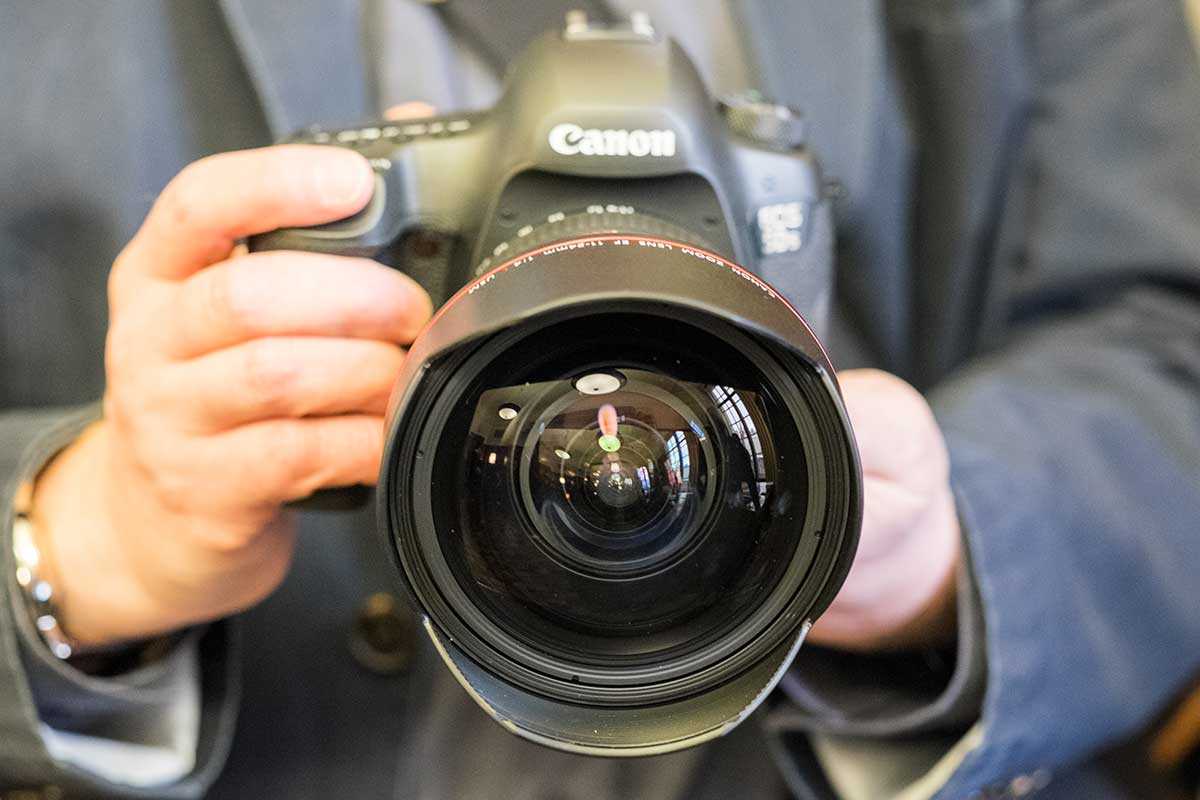
The first thing that strikes you about the lens is the big, bulbous front element
Canon EF 11-24mm f/4L USM Handling and Features
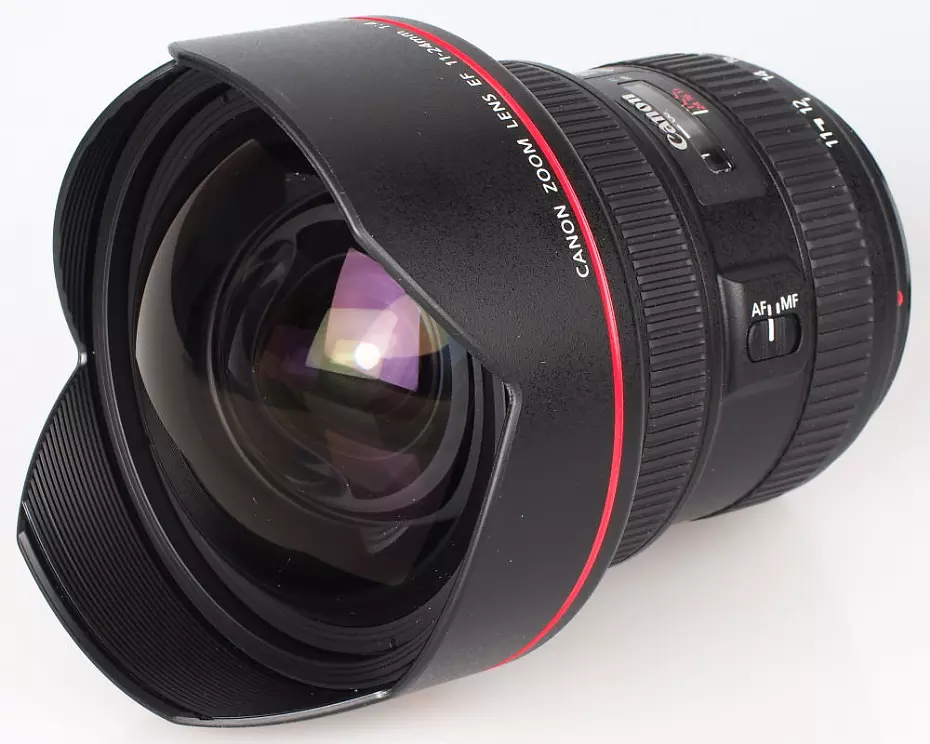
At first glance, this lens looks exactly like it is the bigger brother of Canon’s older 14mm f/2.8 lens. Design and build of this lens is what you’d expect of Canon’s L series, with tough black finished metal and plastics used throughout its construction. There’s a lot of glass in the design of this lens, which adds to the weight, which is still well over a kilogram, despite it sporting a reasonably modest f/4 maximum aperture. The lens balances well enough with the Canon EOS 5D Mk III camera body used for testing, but it may be too large and heavy to use with some of Canon’s more compact camera bodies.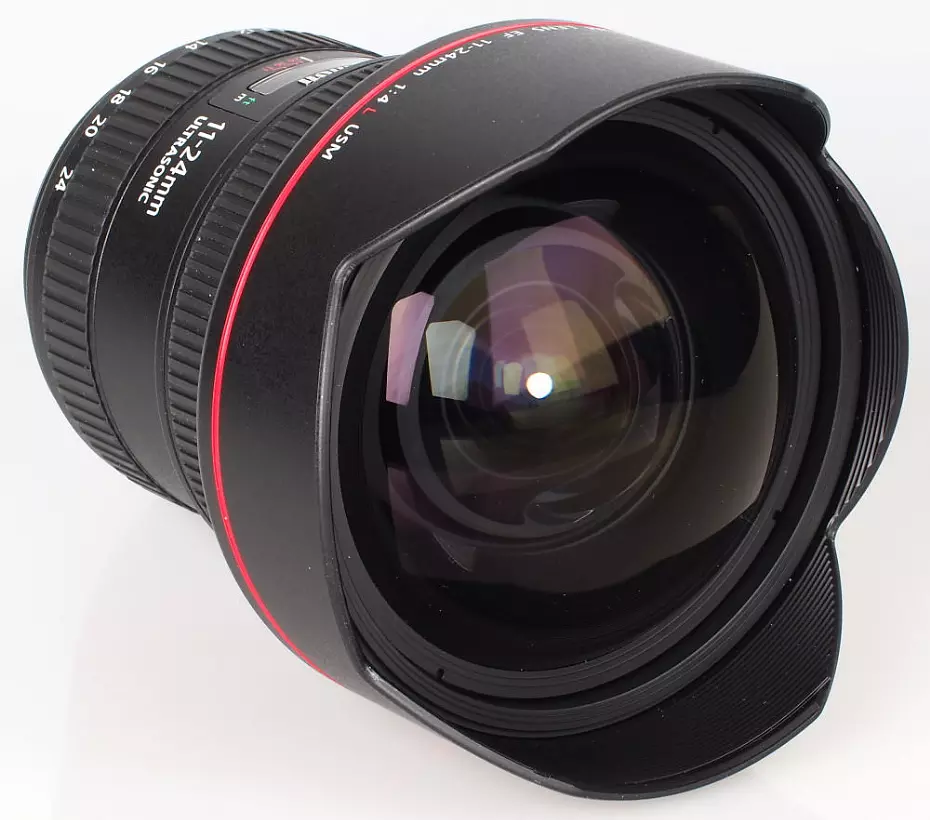
An Ultrasonic motor powers autofocus, which allows manual focus adjustments to be made at any time, and AF speeds are very fast as a result. Manual focus adjustments are a pleasure to apply, thanks to the smooth, precise and well damped focus ring. A distance scale is located on top of the lens behind a small window, which will be especially useful for setting the hyperfocal distance with a calculator, as there is no hyperfocal scale marked on the lens. Closest focus is 28cm which is great for the occasional wide-angle close up image, or for shooting in claustrophobic environments. Estate agents in London will love this feature.
Focusing and zoom are performed internally, although due to the wide angle nature of the lens, and bulbous front element, with integrated hood, you’ll not be fitting filters to this lens easily.
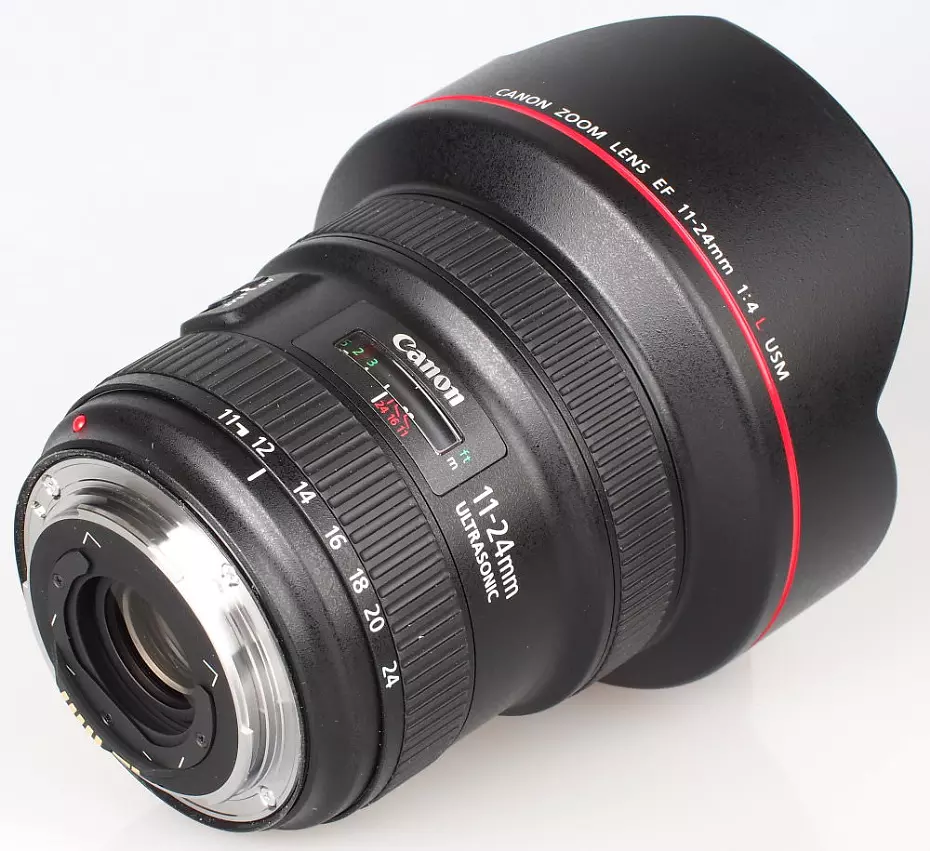
Canon EF 11-24mm f/4L USM – Build and handling
Given the price of this lens, you’d expect exceptional build quality and that’s exactly what you get. In true Canon L-series fashion, the construction and overall finish are sublime, while the size of the lens and its enormous, bulbous front element really make it feel as though you’re holding onto something special.
The space between the zoom ring and focus ring is home to the lens’s focal distance indicator and AF/MF switch, with the latter being positioned off to the side of the barrel and ever so slightly pronounced to make it easier to locate from behind the camera. The zoom and focus rings offer an almost identical level of fluidity as they’re rotated, with the zoom ring operating across its range in just under a quarter of a turn.
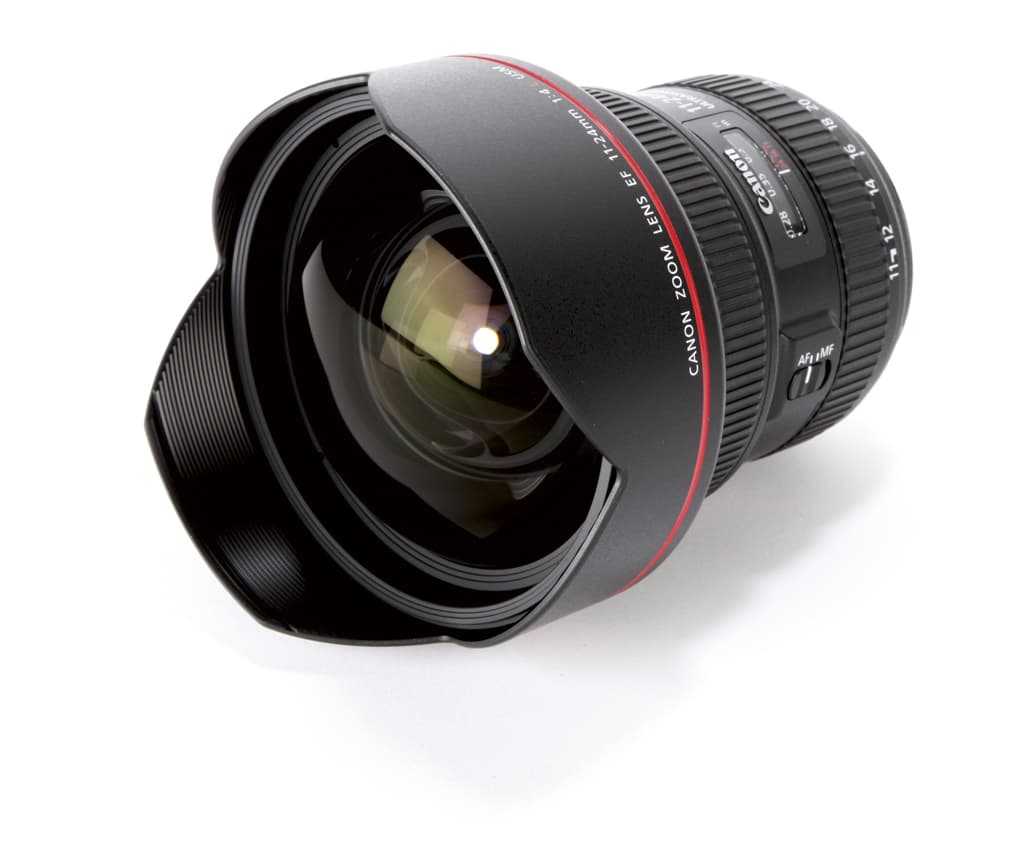 To keep the lens protected from knocks and scrapes, the design incorporates a fixed petal-shaped hood that’s made from strengthened moulded plastic. In use, this hood took quite a battering, helping to shield the glass from accidental impacts that could have otherwise resulted in a costly repair bill for the front element. When not in use, the bespoke lens cap adds further protection, but as we’ll come to shortly, a UV filter cannot be fixed to the lens as an extra precautionary measure.
To keep the lens protected from knocks and scrapes, the design incorporates a fixed petal-shaped hood that’s made from strengthened moulded plastic. In use, this hood took quite a battering, helping to shield the glass from accidental impacts that could have otherwise resulted in a costly repair bill for the front element. When not in use, the bespoke lens cap adds further protection, but as we’ll come to shortly, a UV filter cannot be fixed to the lens as an extra precautionary measure.
In similar fashion to some of Canon’s other wideangle zooms, the lens’s design accepts rear-insert-type gelatine filters, which can be cut to size and inserted behind the rear lens element. Attaching filters to the front element is not as straightforward, however, with the bulbous front element declining the screw-in type of filter. Regrettably, no filter adapter was available at the time of testing, but Lee Filters makes an adapter that enables its SW150 filter holder to be used on the lens. This holder accepts 150 x 150mm and 150 x 170mm filters.
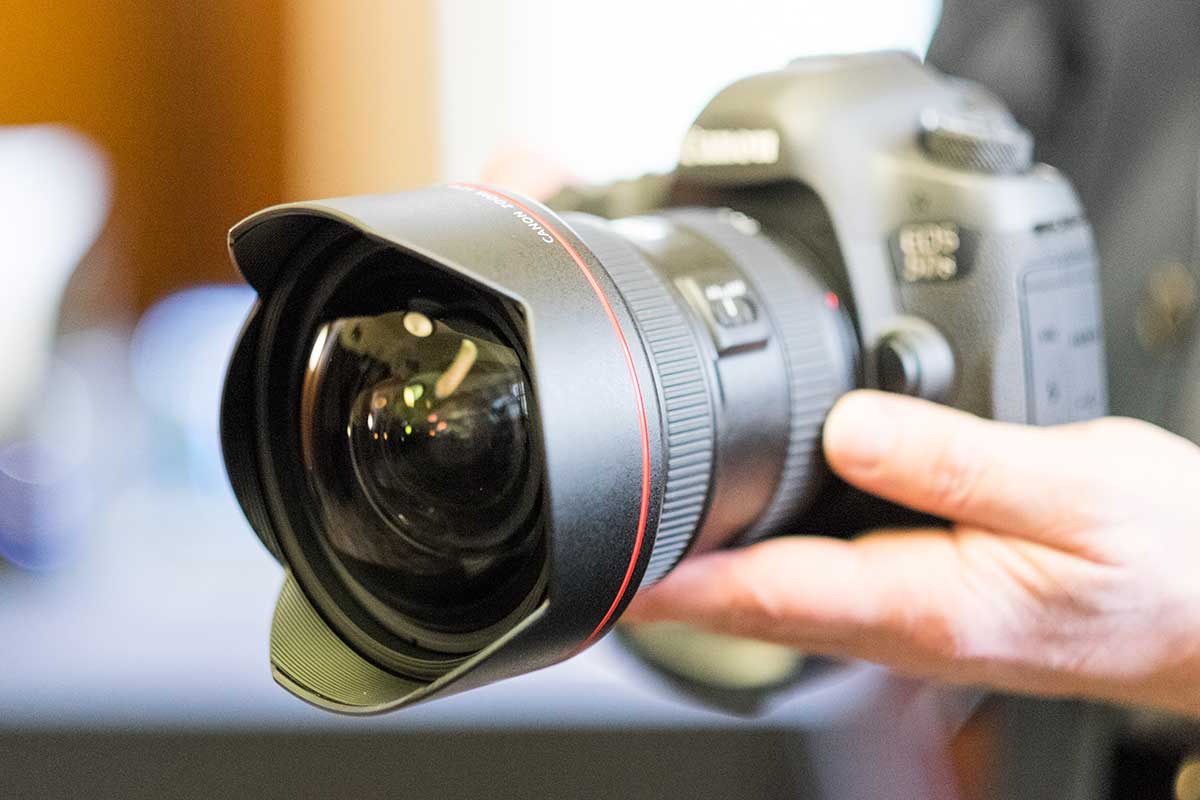
The Canon EF 11-24mm f/4L USM is a weighty optic
Canon EF 11-24mm f/4L USM – Introduction
When it comes to choosing a wideangle lens, photographers using a Canon full-frame DSLR have one of the best ranges available. For those working to a strict budget there’s the very respectable EF 17-40mm f/4 L USM, while for those who can justify the cost there’s the superb EF 16-35mm f/4L IS USM, which benefits from having a built-in optical image stabiliser – a feature Canon’s similarly excellent, but the EF 16-35mm f/2.8L II USM and EF 16-35mm f/2.8L III USM don’t have. If these zooms aren’t wide enough, there’s also the EF 8-15mm f/4L Fisheye USM and the EF 14mm f/2.8L II USM to consider, not forgetting Canon’s wideangle tilt-and-shift TS-E lenses, plus third-party options from the likes of Sigma, Tamron and Tokina.

This image, shot at 11mm, demonstrates the extremely wide angle of view
Although it’s hard to fault this range of wideangle zooms available for full-frame landscape or architectural shooters, there has always been a demand for a zoom lens that covers a wider focal range than 16-35mm and delivers similar, if not better image-quality performance to Nikon’s highly respected AF-S Nikkor 14-24mm f/2.8G ED. For this reason, in February 2015, Canon introduced the EF 11-24mm f/4L USM reviewed here. Its price tag is $2,899/£3,099.
The widest full-frame rectilinear lens currently available for Canon R-series mirrorless cameras is the RF 14-35mm F4L IS USM ( $1,499/£1,7949).
What works
The Canon EF 11-24mm is benchmarked as the widest ultra-wide rectilinear lens compatible with full-frame DSLRs, since the Sigma 12-24mm F/4.5-5.6 lens. Thus barrel distortion is minimal throughout the range, and straight lines in your subject are not compromised (and appear straight). The most distortion you would find occurs at around 11mm and 12mm and compared to any other lens at this focal range, it is minimal. Of note, distortion seems non-existent between 15-24mm.
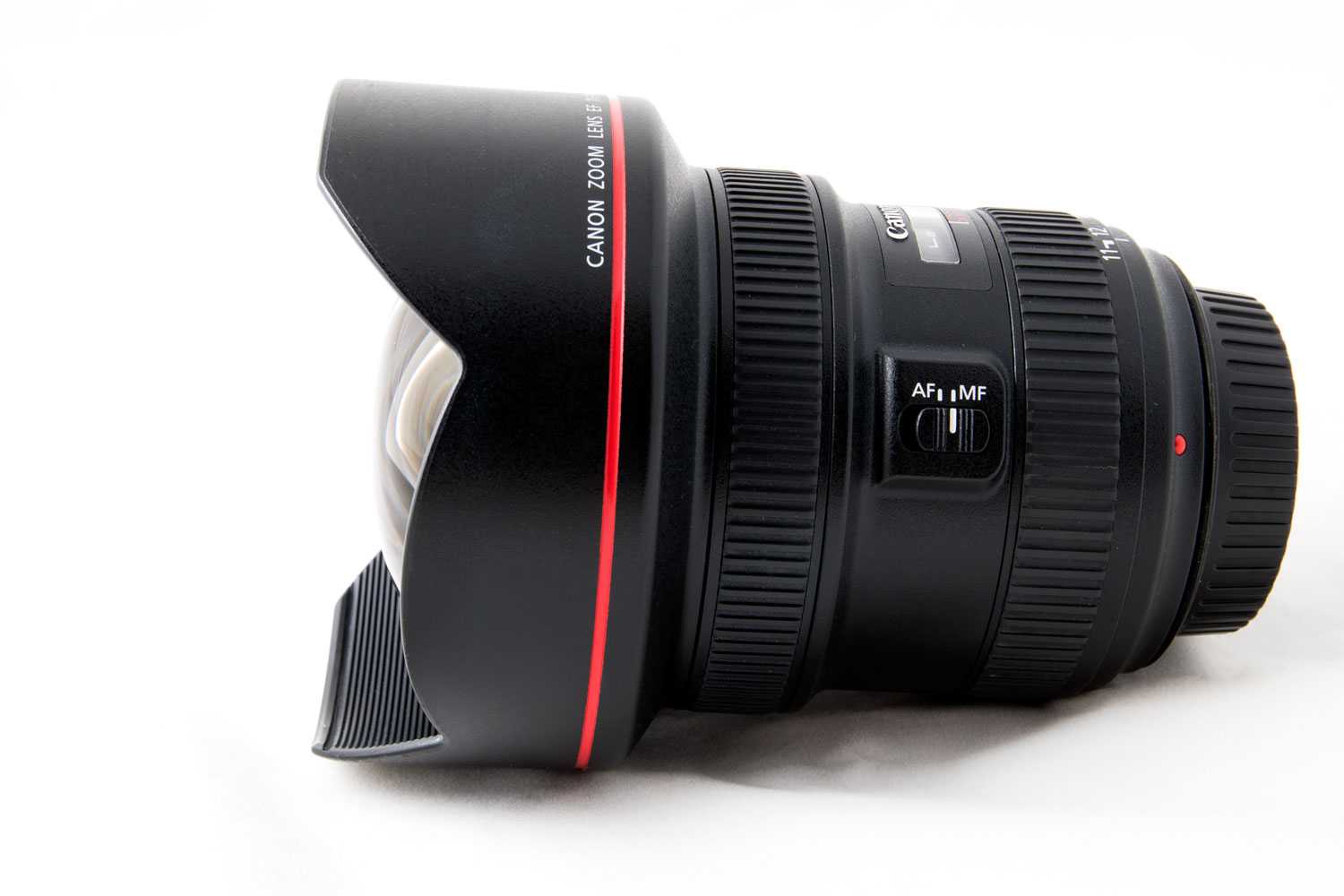
By comparison, yes the Canon EF 8-15mm f/4L Fisheye is wider, but as is the signature of fisheye lenses, it outputs barrel-distorted images and your straight lines curve. The exception is if your line is directly center of your frame.
The lens is quiet and focuses quickly. Most impressively though, it is super sharp, even at the corners! Added to sharp images; the contrast is nice and balanced. If you have used other ultra-wides, you will admire the difference in the output. The image quality is simply amazing!
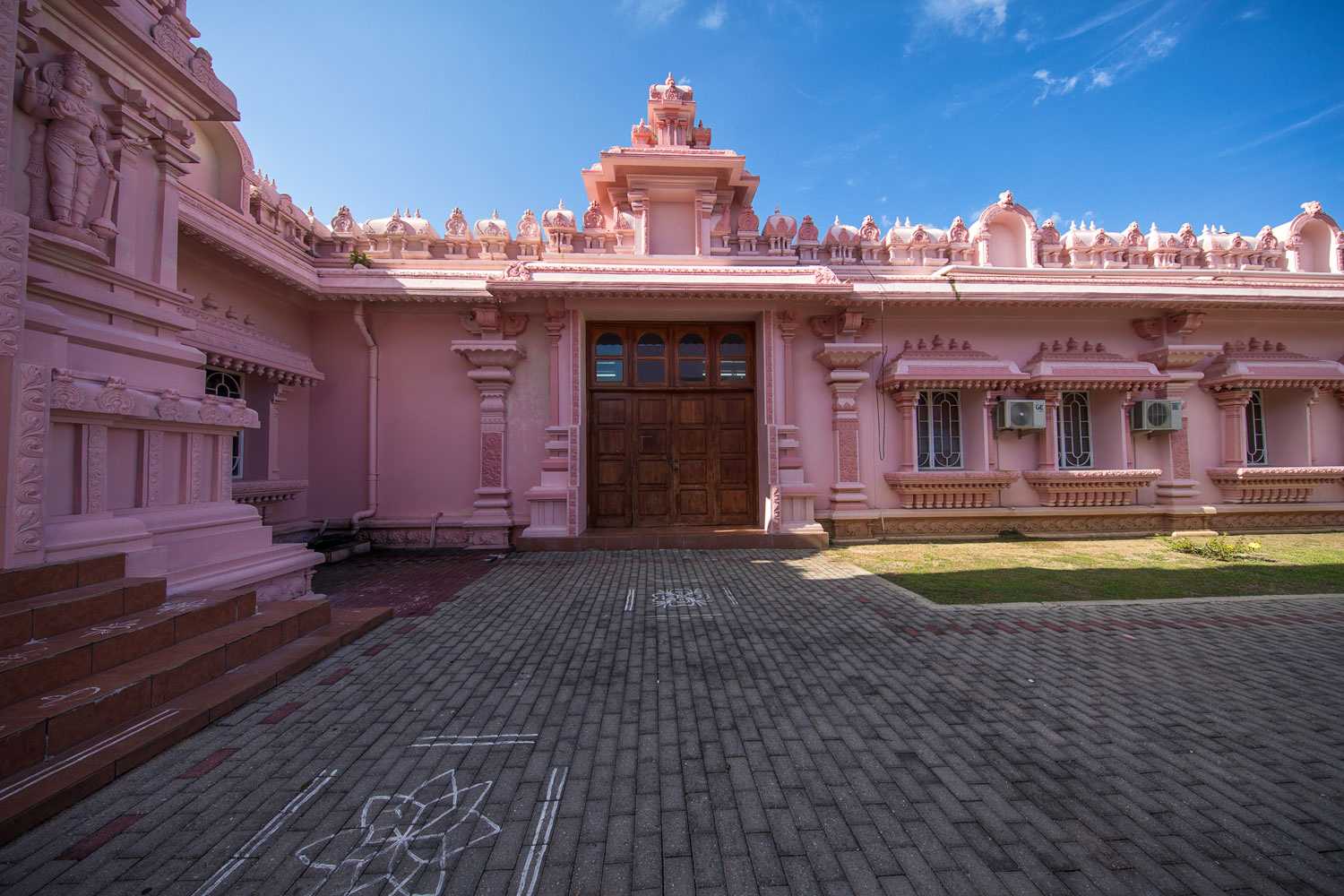
The angle of view on a full-frame, coupled with the minimal distortion, makes it great for indoor architectural spaces. The need for a lens like this to be F/2.8 eludes me, as F/4 feels more than adequate.
Reasons to Buy Canon EF 11-24mm F4L USM Lens
Here we’ve included a summary of the advantages and disadvantages of the Canon EF 11-24mm F4L USM lens in a list form to help you determine whether it offers the features you need.
PROs
| Weather-sealed |
| Autofocus |
| Distance Scale |
| Hood supplied |
| Full-time Manual Focusing |
| Internal Focusing |
| Fast Aperture at Tele end |
| Constant f4 aperture throughout the range |
| Covers Full-Frame Sensor |
| 9 Diaphragm Blades for Smooth Bokeh |
| Extreme Wide-angle capability |
| Minimum focus distance of 0.28m / 11.0 inch |
Report a correction
Buy Canon EF 11-24mm F4L USM from or B&H PHOTO
CONs
| Heavy |
| Pricey |
Lens Mount
Canon EF 11-24mm F4L USM is compatible with cameras that have a Canon EF lens mount. Some of the latest released cameras that are compatible with the Canon EF lenses are Canon 1D X III, Canon 6D MII and Canon 5D MIV.
Size, Weight and Filter Thread
Size and weight is a very important decision factor when searching for your next lens. Canon EF 11-24mm F4L USM has a maximum diameter of 108mm and total length of 132mm. It weighs 1165g / 41.1 oz.
Optical Image Stabilization
Canon EF 11-24mm F4L USM doesn’t have an optical image stabilization system so the only option to stabilize the image taken with this lens is to mount on a camera body with IBIS (sensor based In-body image stabilization).
Zoom Method
Canon EF 11-24mm F4L USM features Rotary (internal) zoom method where the length of the lens doesn’t change while you are zooming in or out. Even though this design has a size disadvantage in general compared to extending designs, it has the benefits of better sealing against dust and moisture, no zoom creep and no weight balance shift while zooming.
Maximum Magnification Ratio
Canon EF 11-24mm F4L USM has a Max Magnification Ratio of 0.16x and has a minimum focusing distance of 0.28m. 0.16x means that the max magnification ratio is very low and not suitable even for modest close-up shots.
Below are the 3 Ultra-Wideangle Zoom type Canon12 mount lens alternatives with highest max magnification ratios:
- Canon 8-15mm f4L Fisheye USM: 0.39x — (Compare)
- Canon 16-35mm F2.8L III: 0.25x — (Compare)
- Canon 17-40mm f4.0L USM: 0.24x — (Compare)
Aperture
Canon EF 11-24mm F4L USM is a fixed aperture lens with a constant max aperture of f4 from 11mm all the way to the 24mm .
| Focal Length | Max Aperture | Min Aperture |
|---|---|---|
| 11mm | F4 | F22 |
| 24mm | F4 | F22 |
Optical Formula
Canon EF 11-24mm F4L USM’s optical formula consists of 16 elements in 11 groups . Following special elements are used in this design:
- Four aspherical
- one Super UD
- one ED elements. Sub-wavelength structure
- air sphere
- super spectra
- fluorine coatings.
Popular Comparisons of Canon EF 11-24mm F4L USM
Top Alternatives of Canon EF 11-24mm F4L USM Lens
| Model | Coverage | Weight | Focusing | Street Price | |
|---|---|---|---|---|---|
|
Sigma 12-24mm F4 DG HSM Art Compare |
35mm FF | 1,151 g / 2.53 lb | AF | ||
|
Canon EF 16-35mm f4L IS USM Compare |
35mm FF | 615 g / 1.35 lb | AF | ||
|
Sigma 14-24mm F2.8 DG HSM Art Compare |
35mm FF | 1,150 g / 2.53 lb | AF | ||
|
Canon EF-S 10-22mm f3.5-4.5 USM Compare |
APS-C / DX | 385 g / 0.85 lb | AF | ||
|
Sigma 10-20mm F3.5 EX DC HSM Compare |
APS-C / DX | 520 g / 1.14 lb | AF | ||
|
Sigma 12-24mm F4.5-5.6 EX DG Aspherical HSM Compare |
35mm FF | 600 g / 1.32 lb | AF | ||
|
Tamron SP AF 10-24mm F3.5-4.5 Di II LD Aspherical IF Compare |
APS-C / DX | 406 g / 0.89 lb | AF | ||
|
Canon EF 16-35mm F2.8L III USM Compare |
35mm FF | 790 g / 1.74 lb | AF |
Альтернативы
Существует ряд альтернатив EF 24mm f/1.4L II USM.
Самый прямой вариант – Sigma Art 24mm f/1.4. Этот объектив стоит примерно в два раза дешевле версии Canon, а оптически он почти такой же. Он не так хорошо сделан, как Canon, но и в этом отношении вполне приличный. Однако известно, что у него есть некоторые проблемы с надежностью фокусировки и больший разброс параметров. Если у вас есть возможность ошибиться при фокусировке, подумайте о приобретении этого объектива, но если нет, ваш выбор сужается.
А Samyang/Rokinon 24mm f/1.4 – это полностью мануальный объектив, привлекательный в основном для астрофотографов и видеосъемщиков. Он немного уступает по оптическим характеристикам, не герметичен и не имеет автофокуса, но за треть цены вы получаете f/1.4 и хорошее качество изображения.
Аналог Canon EF 24mm f/2.8 IS USM – более компактная и медленная альтернатива. При уменьшении до f4 он практически неотличим от своего собрата из серии L по качеству изображения. Он намного меньше и легче и даже имеет полуприличную стабилизацию изображения. Если вам нравится фокусное расстояние 24 мм, но не нужны выдающиеся характеристики в условиях низкой освещенности, этот объектив может стать для вас идеальным вариантом.
Объектив Canon EF 28mm f/1.8 USM схож по производительности в условиях низкой освещенности, но у него есть свои минусы, в основном в области оптики. Этот объектив резкий, но он не может сравниться с 24-мм объективом нигде, кроме центра. Тем не менее, он отлично подходит для получения одинаково размытых фонов на одинаково широком угле.
Объектив Canon EF 16-35mm f/4 IS USM должен стать вашим выбором для пейзажной фотографии. Несмотря на то, что это зум-объектив, качество его изображения практически неотличимо от 24mm f/1.4. Поэтому, если вам не нужна быстрая диафрагма, это более дешевый и универсальный вариант.
Обзор объектива EF 24mm f/1.4L II USM
Объектив 24mm f/1.4 II был представлен в 2008 году, заменив более старое первое поколение. Это самый широкий объектив Canon f/1.4. По сравнению с предшественником, его оптика совершенно иная. Огромное снижение искажений и значительный скачок в резкости и микроконтрасте.
Вы можете быть обеспокоены тем, что этому объективу уже 12 лет, но не стоит: объективы не стареют, как камеры, и этот объектив, скорее всего, останется флагманским 24-мм объективом Canon на долгое время. Однако я ожидаю, что в ближайшем будущем появится специальная версия для нового полнокадрового беззеркального байонета RF.
Это исключительный, но довольно специализированный объектив. На рынке существует множество альтернатив, если вам не нужна именно большая диафрагма. Я расскажу о них в разделе “Альтернативы” ближе к концу, но самые очевидные из них – 24mm f/2.8 IS USM, 28mm f/1.8 USM, или любой из 16-35mm f/2.8 зумов. Существуют также объективы 24mm f/1.4, выпускаемые сторонними производителями.
Обратите внимание, что все изображения в данном обзоре были сняты на широко открытой диафрагме f/1.4, за исключением тех случаев, когда это указано. В коробке находится кожаный чехол, бленда EW-83K и руководство пользователя
В коробке находится кожаный чехол, бленда EW-83K и руководство пользователя.
Как объектив серии L (флагманская линейка Canon), его цена довольно высока. Я нашел фантастическое предложение по продаже подержанного объектива, и, честно говоря, именно по этой причине у меня есть этот объектив. Но после того, как я пользуюсь им уже почти три года, я бы без раздумий приобрел его за полную цену. Однако для вас это может быть не так.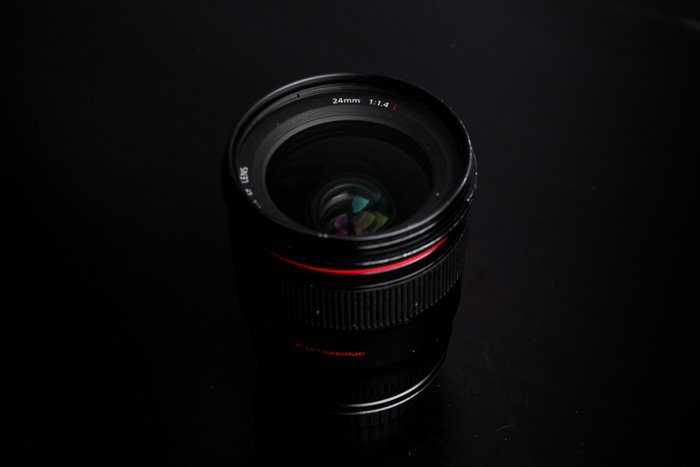
Ease of Use
Weighing in at 1180g and measuring 13cms in length, the Canon EF 11-24mm f/4L USM is a very big lens indeed, almost twice as heavy as the EF 16-35mm f/2.8 lens. While you can use it on a smaller APS-C body for a 16-26mm equivalent angle of view, it won’t balance very well at all. As demonstrated by the images below, it’s a much better match for a professional-grade, full-frame camera like the 5D Mark III, and even then you’d probably want to fit a battery grip when using it hand-held.
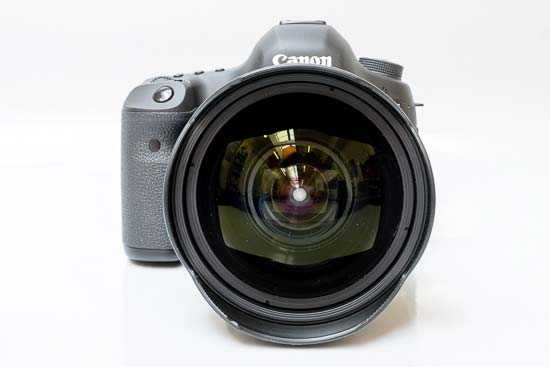 The Canon EF 11-24mm f/4L USM lens mounted on a Canon EOS 5D Mark III
The Canon EF 11-24mm f/4L USM lens mounted on a Canon EOS 5D Mark III
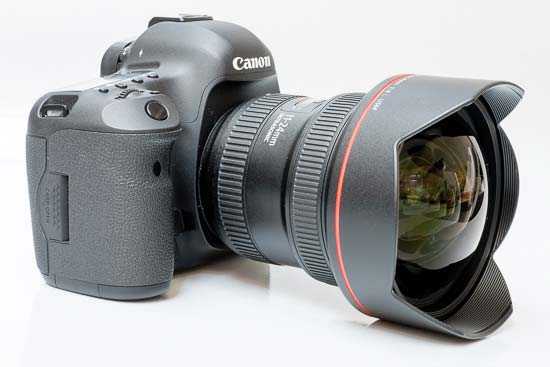 The Canon EF 11-24mm f/4L USM lens mounted on a Canon EOS 5D Mark III
The Canon EF 11-24mm f/4L USM lens mounted on a Canon EOS 5D Mark III
 The Canon EF 11-24mm f/4L USM lens mounted on a Canon EOS 5D Mark III
The Canon EF 11-24mm f/4L USM lens mounted on a Canon EOS 5D Mark III
 The Canon EF 11-24mm f/4L USM lens alongside the Canon EOS 5D Mark III
The Canon EF 11-24mm f/4L USM lens alongside the Canon EOS 5D Mark III
As you would expect from a lens that costs this much, build quality is excellent, certainly up to the «L» moniker that denotes Canon’s premium lenses. The Canon EF 11-24mm f/4L USM feels very solid in your hand, even if the outer barrel and the filter thread appear to be made from plastic. The focusing ring is generously wide and has a ridged, rubberised grip band. It has no aperture ring, which is no big deal unless you wanted to use it on a very old film body. The lens also features a distance scale.
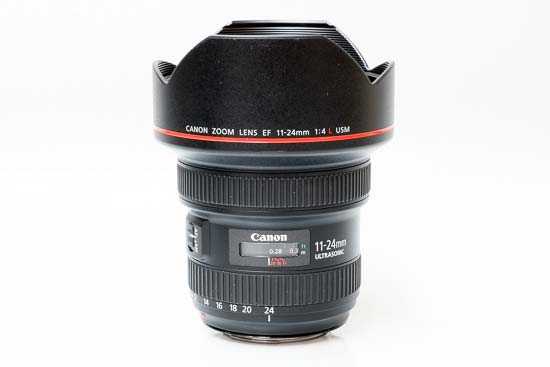 The side of the Canon EF 11-24mm f/4L USM lens
The side of the Canon EF 11-24mm f/4L USM lens
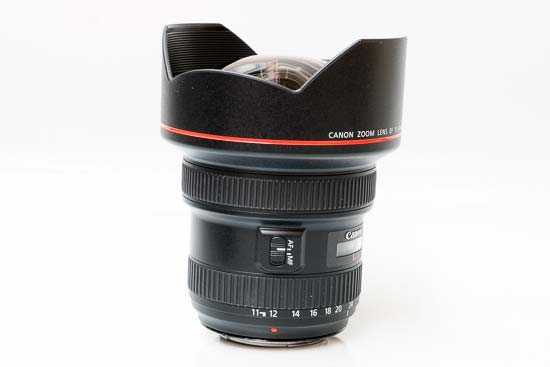 The side of the Canon EF 11-24mm f/4L USM lens
The side of the Canon EF 11-24mm f/4L USM lens
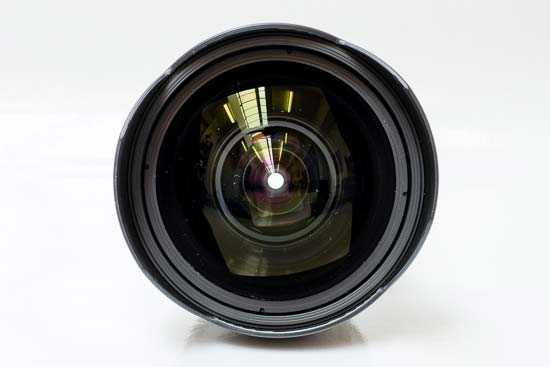 Front of the Canon EF 11-24mm f/4L USM lens
Front of the Canon EF 11-24mm f/4L USM lens
 Rear of the Canon EF 11-24mm f/4L USM lens
Rear of the Canon EF 11-24mm f/4L USM lens
The final control on the lens barrel is a focus mode switch with the usual AF/MF settings. Note that the Canon EF 11-24mm f/4L USM usefully offers full-time manual focusing even when AF is selected.
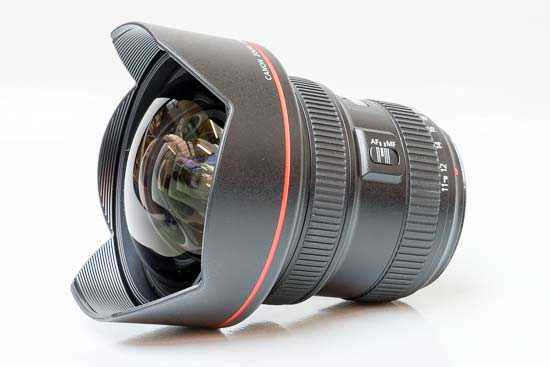 Side of the Canon EF 11-24mm f/4L USM lens
Side of the Canon EF 11-24mm f/4L USM lens
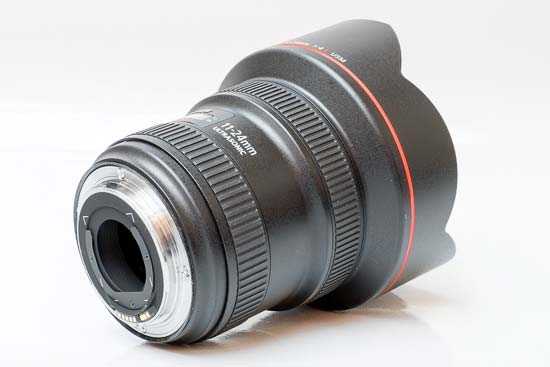 Side of the Canon EF 11-24mm f/4L USM lens
Side of the Canon EF 11-24mm f/4L USM lens
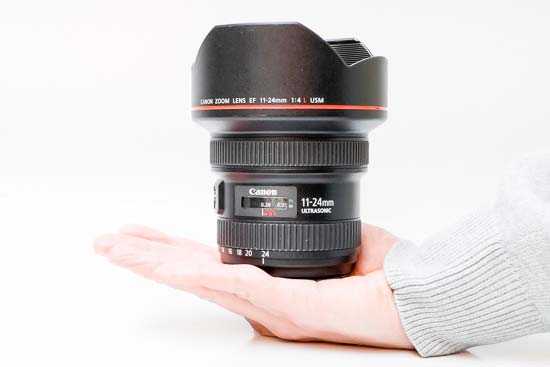 The Canon EF 11-24mm f/4L USM lens in-hand
The Canon EF 11-24mm f/4L USM lens in-hand
The Canon EF 11-24mm f/4L USM lens ships with a non-removable petal-shaped lens hood and a protective drawstring lens case. Given the cost of the lens, we’d have liked to have seen a hard case included.
Focal Range
At the 11mm focal length the angle of view is 117 10′ degrees.
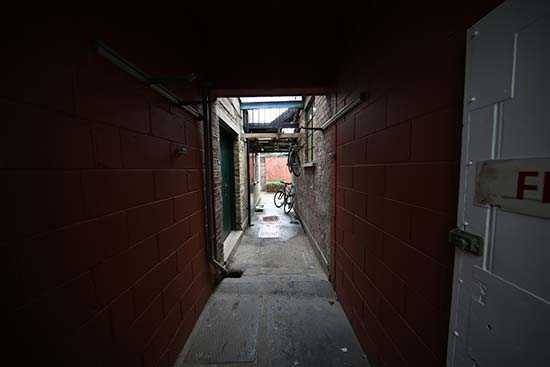 Field of view at 11mm
Field of view at 11mm
At the 24mm focal length the angle of view is 74 degrees.
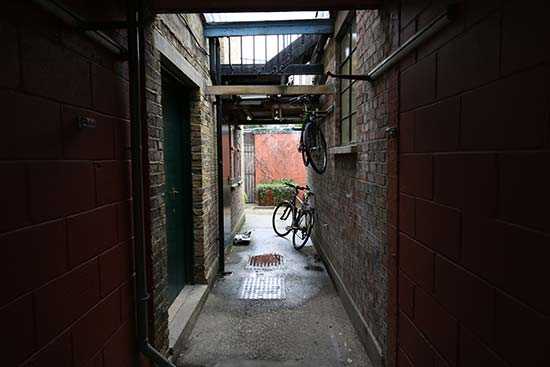 Field of view at 24mm
Field of view at 24mm
Focusing
The Canon EF 11-24mm f/4L USM lens has a fairly wide focus ring. There are hard stops at both ends of the range, making it easier to set focus at infinity. Polariser users should be pleased that the filter holder doesn’t rotate on focus.
When it comes to auto-focusing, the Canon EF 11-24mm f/4L USM zoom is a quick performer, taking about 0.15 seconds to lock onto the subject when mounted on the Canon EOS 5D Mark III that we tested it with.
We didn’t experience much «hunting», either in good or bad light, with the lens accurately focusing almost all of the time. It’s also a fairly quiet performer, thanks to the built-in USM (Ultra Sonic Motor), which makes this lens quite well-suited to video recording.
Chromatic Aberrations
Chromatic aberrations, typically seen as purple or blue fringes along contrasty edges, are impressively well controlled with this lens — the examples below show the worst-case scenario.
Vignetting and Distortion
With the lens wide open at f/4, you can see some very signifcant light fall-off in the corners at both ends of the focal range. Stopping down helps, although to completely get rid of this phenomenon, you will need to use an f-stop of f/8 or smaller.
Barrel distortion is very evident at the 11mm wide-angle focal length, disappearing completely at 24mm.
 Vignetting at 11mm
Vignetting at 11mm
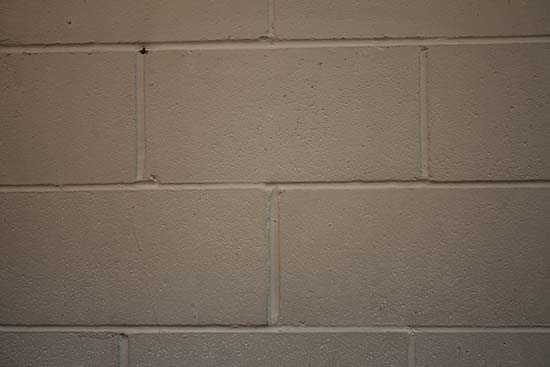 Vignetting at 2mm
Vignetting at 2mm
Macro
The Canon EF 11-24mm f/4L USM is not a macro lens. The closest focus point is at 28cm from the film/sensor plane when the focal length is set to 24mm, and Canon quotes a maximum reproduction ratio of 0.16x for the lens. The following example illustrates how close you can get to the subject.
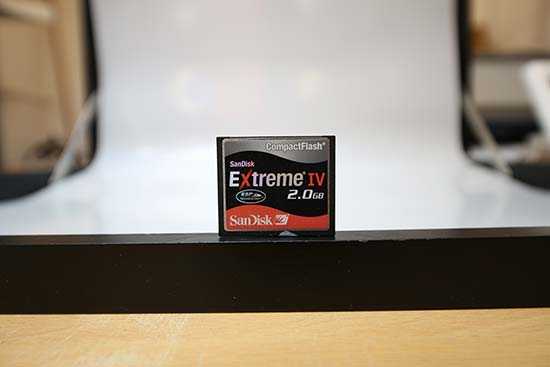 Close-up performance
Close-up performance
Sharpness
In order to show you how sharp this lens is, we are providing 100% crops on the following pages.
- Ease of Use
- Sharpness: 11mm
-
14mm
-
18mm
-
24mm
- Sample Images
- Lens Specs
- Rating & Conclusion
- Main Rivals
- Review Roundup
Canon EF 11-24mm f/4L USM – Our verdict
Canon and its engineers must be praised for constructing one of their finest L-series lenses, and for the way they’ve created one of the best, if not the best, rectilinear wideangle zooms ever made. If you’re a full-frame user who specialises in landscape, architectural or interior photography, and demand a lens that’s not only capable of squeezing as much of your surroundings as possible into the frame, but does so with exceptional optical performance, this is one to add to your wish list. The lens’s price tag is likely to be more than most can justify, which means it will probably creep into more pros’ bags than enthusiasts’. That said, the ability to hire lenses means it’s not entirely out of reach for a one-off shoot with an absolutely outstanding piece of glass.  Canon EF 11-24mm f/4L USM at a glance:
Canon EF 11-24mm f/4L USM at a glance:
• 16 Elements in 11 Groups
• 9 Diaphragm blades
• 28cm minimum focus distance
• Dimensions: 108x132mm
• Weight 1180g
• $2,899/£3,099
Canon EF 11-24mm f/4L USM – Image quality
Architectural and landscape photographers looking at this lens will be glad to read that it puts in a truly remarkable image-quality performance. For the finest wideangle results, users will want to use the lens at its 16mm setting and dial in an aperture of f/8-f/11 where sharpness is at its optimum. Inspecting the corners of images at this focal length reveals virtually no trace of barrel or pincushion distortion, and although the sharpness in the corners at f/4 isn’t quite what it is at f/8, it remains impressively sharp and is by all means usable when a faster shutter speed is required.
As is to be expected, pulling back the lens to its 11mm setting demonstrates some barrelling, but considering the generous width of this lens, I expected this barrel distortion to be far more severe. At the opposite end of the focal length, there is some evidence of pincushion distortion at 24mm, but this was more noticeable in our lab tests than in real-life images, and should be easily fixed by applying a lens profile as soon as one becomes available from DxO or Adobe.
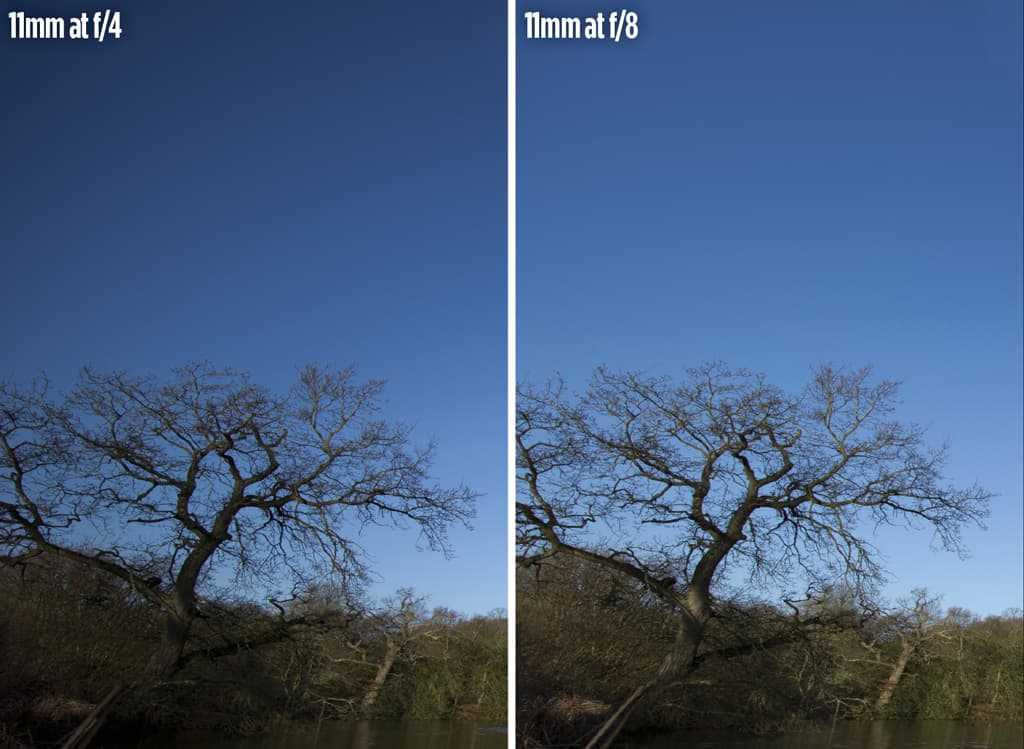
Vignetting is apparent at f/4, but this becomes less obvious when the aperture is closed towards f/8
Inspecting the corners of the frame did reveal signs of vignetting – most noticeable at the widest end of the zoom with the aperture opened to its maximum. Unlike some lenses, though, the effect of this vignetting is tasteful and helps to draw the viewer’s eye gradually to any central subject in the image. Closing the aperture from f/4 to f/8 removed all signs of vignetting at 11mm, while at 16mm it was less visible once closed down to f/5.6.
Studying images for chromatic aberrations did bring my attention to some purple and green edges along high-contrast edges. However, these faint fringes of colour are well controlled and aren’t obvious unless images are viewed at a magnification of 100% or more. Again, these aberrations should be fixed relatively easily by applying a specific profile for the lens in raw conversion software, as soon as they become available.
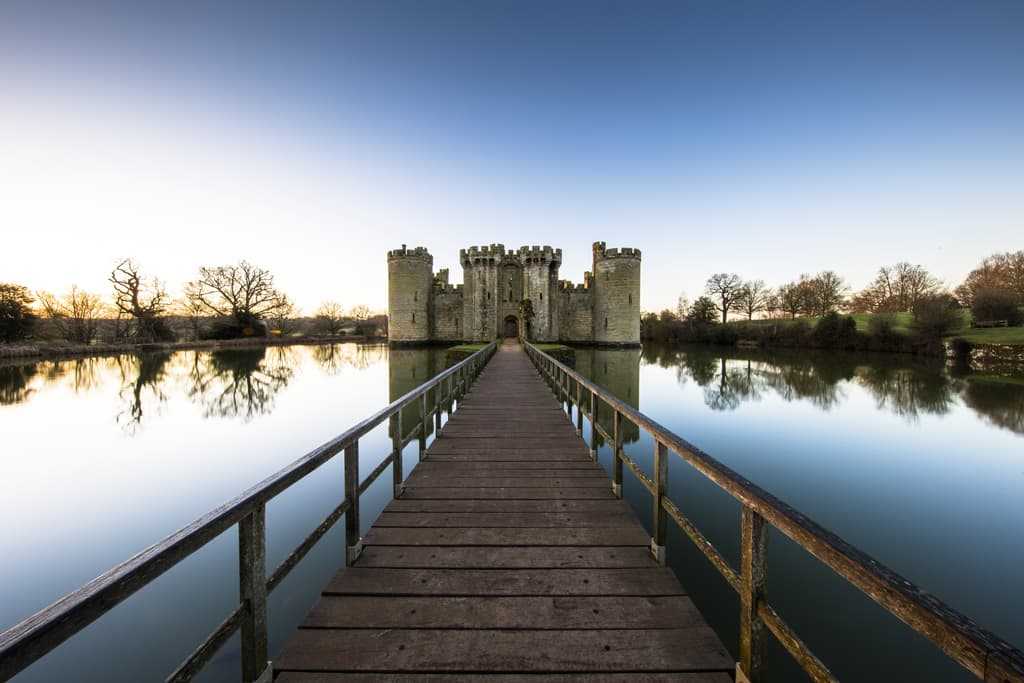
The lens excels at the speed it focuses, locking onto subjects accurately and precisely with negligible fuss
Buy Now
Used Canon EF-S 17-55mm f/2.8 IS USM
Heavily Used £199
Used Canon EF 55-200mm f/4.5-5.6 II USM
Heavily Used £54
Used Canon EF 500mm f/4.5 L USM
Heavily Used £799
Used Canon EF-S 17-85mm f/4-5.6 IS USM
Heavily Used £54
Used Canon EF-M 32mm f/1.4 STM
Like New £404
Used Canon EF-M 18-55mm f/3.5-5.6 IS STM
Like New £104
Used Canon EF 70-200mm f/2.8 L IS III USM
Like New £1599
Used Canon RF 35mm f/1.8 IS STM Macro
Like New £414
Used Canon RF 50mm f/1.8 STM
Like New £194
Used Canon EF-S 18-55mm f/3.5-5.6 III
Like New £44
Sell or trade used photo and video kit with MPB
|
We don’t have the latest price however the link below will take you to the most relevant items. Canon EF 11-24mm f/4L USM |
We don’t have the latest price however the link below will take you to the most relevant items. Canon EF 11-24mm f/4L USM |
We transform the way that people buy, sell and trade in photo and video kit. USED CANON |
Support this site by making a Donation, purchasing Plus Membership, or shopping with one of our affiliates:
Amazon UK,
Amazon US,
Amazon CA,
ebay UK,
MPB. It doesn’t cost you anything extra when you use these links, but it does support the site, helping keep ePHOTOzine free to use, thank you.
ADVERTISEMENT
Other articles you might find interesting…
Nikkor Z DX 24mm F/1.7 Lens Review
Fujifilm XF 8mm F/3.5 Review
Canon RF-S 55-210mm Review
SIGMA AF 14mm f/1.4 DG DN | Art Lens Review
Best Third Party Nikon F Lenses (DSLR)
Astrodesign & Samyang Join The L-Mount Alliance
Best Canon EF And EF-S Lenses
Sony FE 70-200mm f/4 G OSS II Lens Announced — Take A Look A…
Для кого предназначен EF 24mm f/1.4L II USM?
Такой объектив подходит далеко не всем. Есть три типа фотографов (на мой взгляд), которым нужен объектив типа 24mm f/1.4. Давайте рассмотрим их один за другим.
Первыми и, вероятно, самыми популярными являются фотожурналисты, фотографов событий, и других документалистов, которым необходимо снимать движение при слабом освещении. Для этой задачи я не смог найти лучшего объектива после многих лет поисков. Диафрагма f/1,4 обеспечивает выдержки, близкие к нулю, в очень темных ситуациях.
Автофокус способен не отставать от него в скорости и точности – именно здесь большинство конкурентов терпят неудачу. Я снимал этим объективом демонстрации, уличные мероприятия, концерты, а также ночные уличные фотографии без каких-либо проблем.
Второе – это те, кому нужен очень выразительный взгляд, который может дать широкоугольный объектив с быстрой диафрагмой. Несмотря на короткое фокусное расстояние, при f/1,4 вы сможете заметно размыть фон на расстоянии 2-3 метров. Такая эстетика может придать особую атмосферу даже самым скучным сценам, хотя не стоит ожидать, что она сама по себе спасет ваши фотографии.

Третья категория – астрофотографы, которые могут извлечь реальную пользу из огромных возможностей по сбору света, которые предлагает 24 f/1.4 II. Он может быть полезен для съемки пейзажей ночного неба, а также Млечного Пути или других астроизображений. Однако в этом случае 24 мм может оказаться слишком узким. Честно говоря, в этой области я использовал этот объектив меньше всего. Я пробовал его несколько раз, но астрофотография никогда не была моим увлечением.
Кроме того, EF 24 f/1.4 II – исключительный объектив для видеосъемки. У него красивый, фирменный внешний вид, отличная контрастность и резкость, а также отсутствие видимых искажений. Он оснащен длинноходным и точным кольцом ручной фокусировки с механическим контактом, поэтому ручная фокусировка с ним настолько хороша, насколько это вообще возможно. Фокусное расстояние 24 мм полезно как в полнокадровом режиме, так и в режиме кропа Super35 (что примерно соответствует кропу APS-C).
Однако следует отметить, что для того, чтобы в полной мере оценить и использовать этот объектив для фотографии, вам потребуется полнокадровая камера. Когда вы находитесь в ценовом диапазоне, превышающем стоимость полнокадровой зеркальной камеры низшего класса (или подержанной профессиональной), вы не захотите выбрасывать половину кадра. Ни в одном из перечисленных выше случаев использования вы не сможете получить максимальную отдачу от этого объектива с кроп-сенсорной камерой.

Необходимо поговорить и о тех случаях использования, когда такой объектив не нужен. Это пейзаж, натюрморт, портрет, улица, путешествия, семья, архитектура, недвижимость, еда и многие другие жанры фотографии. Конечно, я сам использую его для некоторых из них, но только потому, что он у меня уже есть, а не наоборот.
Introduction
The Canon EF 11-24mm f/4L is the world’s widest-angle rectilinear zoom lens. Featuring three aspherical lenses including a ground aspherical element which maximises image quality and delivers minimal levels of distortion, Super Spectra coatings to reduce ghosting and flare, fluorine coatings on the front and rear elements to prevent dust and water drops sticking to each element, water and dust resistantance, an ultrasonic focus motor, a nine-blade circular aperture, silent high-speed AF performance, full-time manual focusing, the new Canon 11-24mm lens offers a complete range of ultra wide-angle focal lengths in a single optic. The Canon EF 11-24mm f/4L USM is available now for £2799.99 / $2999.99 in the UK and the USA respectively.
Canon EF 11-24mm f/4L USM Performance
Between 11mm and 16mm, sharpness is already outstanding in the centre of the frame at maximum aperture, with performance towards the edges of the frame being very good. At 11mm, stopping down results in little improvement in clarity towards the edges of the frame, but at 16mm, excellent performance is realised with the aperture stopped down to f/8.
At 24mm, sharpness remains outstanding in the centre of the frame at maximum aperture, and excellent towards the edges of the frame. Stopping down to f/5.6 results in outstanding sharpness across the frame.
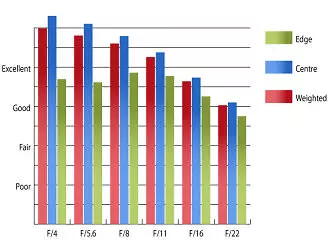
MTF@11mm

MTF@16mm
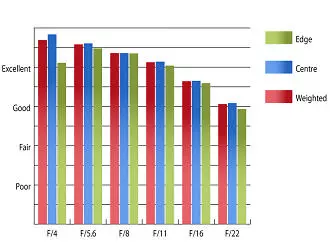
MTF@24mm
How to read our charts
The blue column represents readings from the centre of the picture frame at the various apertures and the green is from the edges. Averaging them out gives the red weighted column.
The scale on the left side is an indication of actual image resolution. The taller the column, the better the lens performance. Simple.
For this review, the lens was tested on a Canon EOS 5D MK III using Imatest.
Chromatic aberrations are well controlled for a lens this wide, just approaching a pixel width at f/4 and 11mm. This low level should cause few issues, even in large prints and harsh crops from the edges of the frame.

CA@11mm
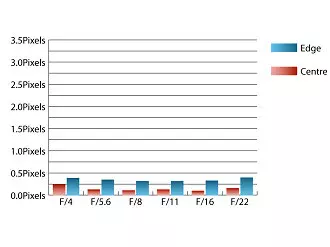
CA@16mm
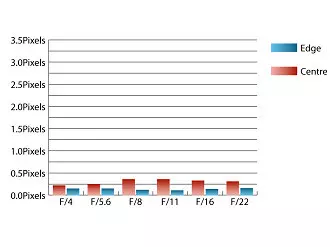
CA@24mm
How to read our charts
Chromatic aberration is the lens’ inability to focus on the sensor or film all colours of visible light at the same point. Severe chromatic aberration gives a noticeable fringing or a halo effect around sharp edges within the picture. It can be cured in software.
Apochromatic lenses have special lens elements (aspheric, extra-low dispersion etc) to minimize the problem, hence they usually cost more.
For this review, the lens was tested on a Canon EOS 5D MK III using Imatest.
Falloff of illumination towards the corners of the frame is reasonably well controlled for a lens covering such a wide angle of view, with the corners being 2.84 stops darker than the image centre at 11mm and 1.3 stops darker than the centre at 24mm. Visually uniform illumination is achieved with the lens stopped down to f/8 throughout the zoom range.
Distortion is reasonable for a lens of this type. At 11mm 6.9% barrel distortion is present, which is replaced by a negligible amount of barrel distortion at 24mm. The distortion pattern has a very slight wave, being present in straight lines parallel to the edge of the frame. This may make applying corrections in image editing software afterwards more tricky, unless the software you use has a preset distortion profile to use.
This lens is very resistant to flare and contrast is excellent, even when shooting into the light.
The build
The moment you pick up this lens, the weight surprises you. It’s quite hefty and you notice every ounce of the approximate (just over) two-and-a-half pounds. The entire build of the lens screams quality too. Like other Canon lenses, the manual focus and zoom rings move smoothly and feel natural. Not a lens you want to be cumbersome with, so this was an important feature for me when working with such weight. You can make easy focal adjustments, as the zoom moves through the entire focal range with a small turn. When behind the lens, the AF/MF is also easily accessible.
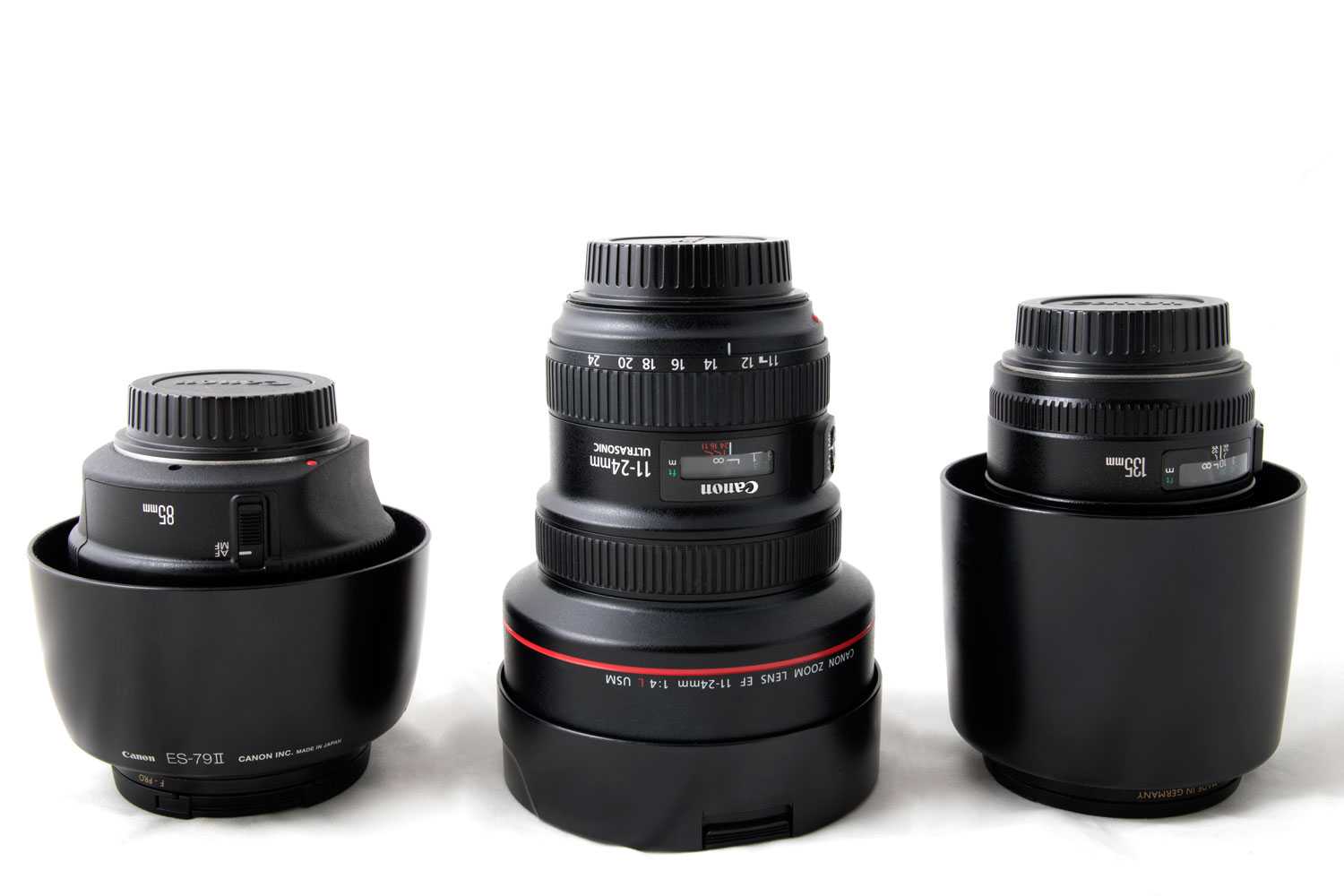
The bulbous front element blooms with authority and still makes me nervous enough to cover it almost immediately when not in use. I am not reassured by the presence of the fixed hood that is meant to protect the imposing glass. However, I am glad it is there. The signature red ring around the front always sets expectations of promised image quality and Canon has delivered.
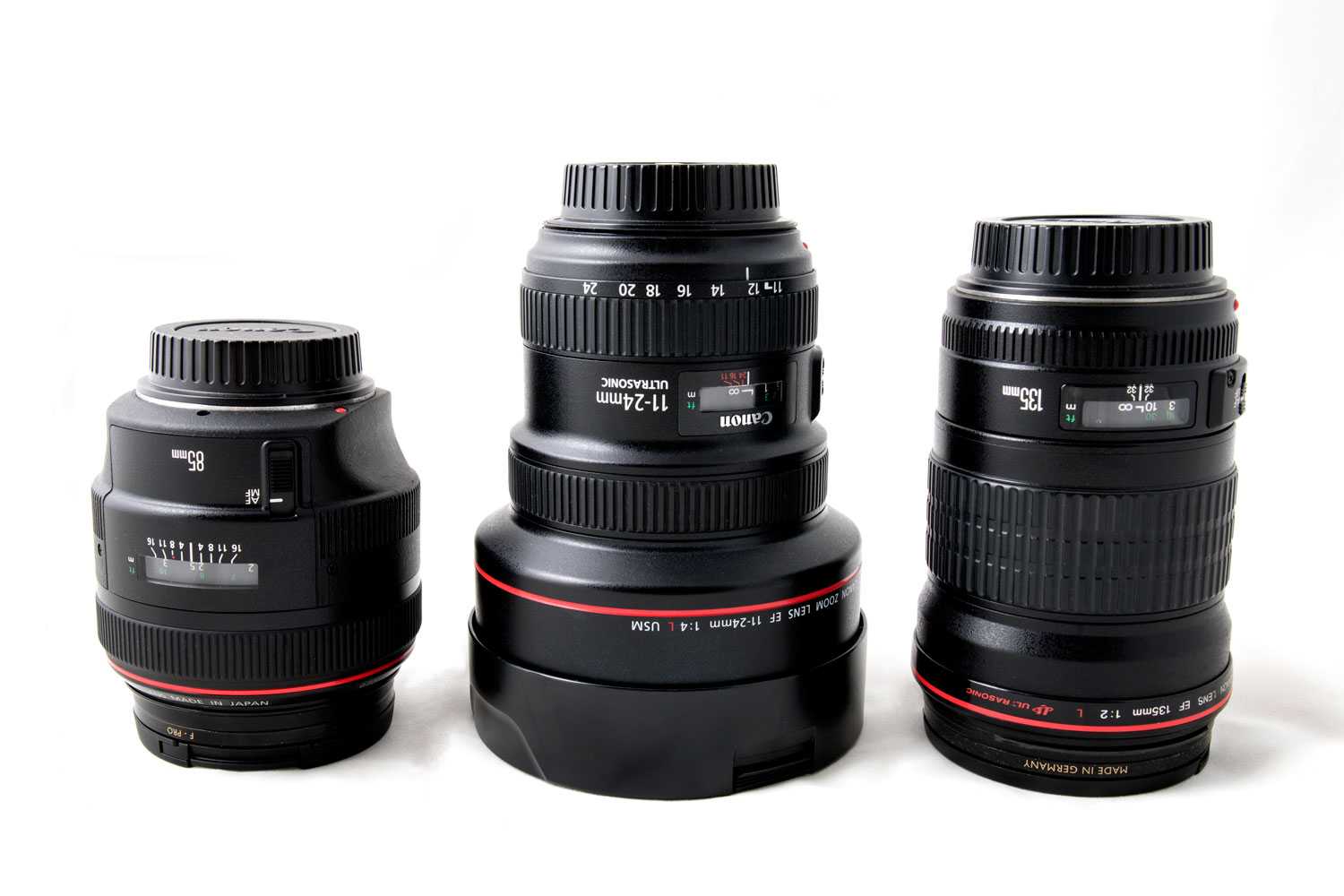
Size comparatives from left to right: Canon 85mm F/1.2 L, Canon 11-24mm F4 L, Canon 135mm F2 L
Sample Images
The thumbnails below link to full-sized samples taken with the Canon EF 11-24mm f/4L USM lens mounted to a Canon EOS 5D Mark III.
Download
1/50s · f/11 · ISO 100
Download Original
Download
1/50s · f/11 · ISO 100
Download Original
Download
1/50s · f/11 · ISO 100
Download Original
Download
1/125s · f/11 · ISO 100
Download Original
Download
1/30s · f/8 · ISO 400
Download Original
Download
1/40s · f/8 · ISO 400
Download Original
Download
1/40s · f/8 · ISO 160
Download Original
Download
1/40s · f/8 · ISO 125
Download Original
Download
1/30s · f/8 · ISO 100
Download Original
Download
1/30s · f/8 · ISO 100
Download Original
Download
1/30s · f/8 · ISO 100
Download Original
Download
1/30s · f/8 · ISO 200
Download Original
Download
1/40s · f/5.6 · ISO 640
Download Original
Download
1/30s · f/8 · ISO 200
Download Original
Download
1/30s · f/11 · ISO 400
Download Original
Download
1/30s · f/11 · ISO 640
Download Original
Download
1/80s · f/11 · ISO 100
Download Original
Download
1/50s · f/11 · ISO 100
Download Original
Download
1/60s · f/11 · ISO 100
Download Original
Download
1/50s · f/8 · ISO 100
Download Original
Download
1/160s · f/8 · ISO 100
Download Original
Download
1/100s · f/8 · ISO 100
Download Original
Download
1/40s · f/16 · ISO 500
Download Original
Download
1/60s · f/16 · ISO 100
Download Original
Download
1/40s · f/16 · ISO 250
Download Original
Download
1/40s · f/16 · ISO 250
Download Original
Download
1/60s · f/16 · ISO 100
Download Original
Download
1/30s · f/16 · ISO 125
Download Original
Download
1/30s · f/16 · ISO 100
Download Original
Download
1/30s · f/16 · ISO 160
Download Original
Download
1/30s · f/16 · ISO 100
Download Original
Download
1/60s · f/16 · ISO 100
Download Original
Download
1/30s · f/16 · ISO 160
Download Original
Download
1/40s · f/16 · ISO 160
Download Original
Download
1/50s · f/16 · ISO 100
Download Original
Download
1/160s · f/11 · ISO 100
Download Original
Download
1/100s · f/11 · ISO 100
Download Original
Download
1/30s · f/8 · ISO 200
Download Original
Download
1/40s · f/8 · ISO 200
Download Original
Download
1/40s · f/22 · ISO 320
Download Original
Download
1/30s · f/16 · ISO 160
Download Original
Download
1/80s · f/8 · ISO 100
Download Original
Download
1/125s · f/8 · ISO 100
Download Original
Download
1/125s · f/8 · ISO 100
Download Original
Download
1/160s · f/16 · ISO 100
Download Original
Download
1/160s · f/16 · ISO 100
Download Original
Download
1/160s · f/16 · ISO 100
Download Original
Download
1/125s · f/16 · ISO 100
Download Original
Download
1/160s · f/16 · ISO 100
Download Original
Download
1/50s · f/16 · ISO 100
Download Original
Download
1/60s · f/11 · ISO 100
Download Original
Download
1/400s · f/11 · ISO 100
Download Original
Download
1/1250s · f/4 · ISO 100
Download Original
Download
1/160s · f/8 · ISO 100
Download Original
Download
1/125s · f/8 · ISO 100
Download Original
Download
1/200s · f/8 · ISO 100
Download Original
Download
1/200s · f/8 · ISO 100
Download Original
Download
1/500s · f/8 · ISO 100
Download Original
Download
1/125s · f/11 · ISO 100
Download Original
Download
1/160s · f/11 · ISO 100
Download Original
Download
1/160s · f/11 · ISO 100
Download Original
Download
1/50s · f/22 · ISO 100
Download Original
Download
1/500s · f/11 · ISO 100
Download Original
Download
1/160s · f/16 · ISO 100
Download Original
Download
1/125s · f/16 · ISO 100
Download Original
Download
1/60s · f/16 · ISO 100
Download Original
Download
1/40s · f/16 · ISO 160
Download Original
Download
1/40s · f/16 · ISO 125
Download Original
Download
1/30s · f/16 · ISO 160
Download Original
Download
1/40s · f/16 · ISO 100
Download Original
Download
1/50s · f/16 · ISO 100
Download Original
Download
1/40s · f/16 · ISO 125
Download Original
Download
1/100s · f/11 · ISO 100
Download Original
Download
1/40s · f/4 · ISO 1000
Download Original
Download
1/30s · f/4 · ISO 1600
Download Original
Download
1/30s · f/4 · ISO 1000
Download Original
Previous Page
« Sharpness: 4
Next Page
Lens Specs »
- Ease of Use
- Sharpness: 11mm
-
14mm
-
18mm
-
24mm
- Sample Images
- Lens Specs
- Rating & Conclusion
- Main Rivals
- Review Roundup











